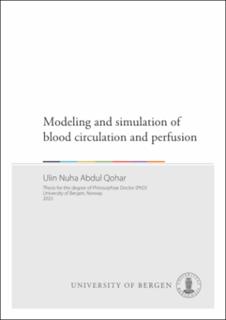| dc.contributor.author | Qohar, Ulin Nuha Abdul | |
| dc.date.accessioned | 2023-06-05T13:30:45Z | |
| dc.date.available | 2023-06-05T13:30:45Z | |
| dc.date.issued | 2023-06-16 | |
| dc.date.submitted | 2023-06-03T03:54:20Z | |
| dc.identifier | container/03/ff/bf/46/03ffbf46-ef9d-459a-ae45-d06ec1250765 | |
| dc.identifier.isbn | 9788230866382 | |
| dc.identifier.isbn | 9788230846117 | |
| dc.identifier.uri | https://hdl.handle.net/11250/3069973 | |
| dc.description.abstract | Numeriske simuleringer har hatt vesentlig betydning for vår forståelse av perfusjon og blodsirkulasjon, og simuleringer gir også viktig innsikt under utviklingen av medisinske anvendelser. Teknologiske fremskritt har muliggjort bruken av mer realistiske modeller, ikke bare i form av mer kompleks fysikk, men også ved at en kan studere sirkulasjonen i hele organer. Disse kjennetegnene er ofte av interesse da fysiologiske egenskaper er forskjellige på tvers av romlige størrelsesordener.
Denne avhandlingen fokuserer på modellering og simulering av blodstrøm, sporstofftransport og perfusjon i organvev. De fysiske prosessene er uttrykt i en flerskala strømningsmodell der segmenterte arterier og vener danner en nettverksmodell for vaskulær strømning, og som er knyttet til en mikrosirkulasjonsmodell. Den ikkeobserverbare vaskulaturen beskrevet av modellen simuleres både med en kontinuerlig og en diskretisert tilnærming.
Vi presenterer et flerskala rammeverk for å studere blodsirkulasjon. Det nytenkende aspektet ved rammeverket består i å kombinere en eksisterende hybrid strømningsmodell for flerskala sirkulasjon med vaskulærfremkalte ikke-lineariteter som har opphav i bl.a. veggelastisiteten og kurvaturen til blodkarene. Anvendelsen av en passende betingelse fra lineær algebra gjør at vi effektivt kan løse det tilknyttede ikke-lineære systemet ved bruk av en iterativ Newtons metode, og det relativt enkle rammeverket beskriver slik blodsirkulasjon i et komplekst fysisk domene med en lav beregningsmessig kostnad.
Modellene og deres tilhørende implementeringer presenteres i artiklene som utgjør Del II i avhandlingen. Her foreslår vi et rammeverk for å generere digitale fantomer for avbildning av perfusjon, og ved å evaluere kinetikkmodeller for sporstoff demonstrerer vi de betydelige verdiene som finnes i etterbehandling av medisinske data. I tillegg undersøker vi optimale vaskulære nettverk som avslører en kompleks gjensidig avhengighet mellom geometrien til det vaskulære nettverket, kapillærene og organene.
Resultatene fra denne avhandlingen bidrar til en bedre forståelse av blodperfusjonsmodeller i vev og potensialet til disse, samt potensialet som vitenskapelig databehandling har i medisinske anvendelser utover perfusjonsavbildning. | en_US |
| dc.description.abstract | Numerical simulations have become essential for understanding blood circulation and perfusion, as well as providing important insights for medical applications. More realistic models have become possible with technological advances, not only in the form of more complex physics, but also in the flow detail of an entire organ circulation. These characteristics are frequently of interest because blood vessels at different spatial scales have different physiological properties.
This thesis focuses on the modeling and simulations of blood flow, tracer transport, and perfusion in an organ tissue. The physical processes are expressed in a multiscale flow model with segmented arteries and veins forming a vascular network flow model that is connected to a microcirculation model. The unobservable vasculature, including small vessels and capillaries, represented by the connection model, is simulated by using a continuum and discrete approach.
A multiscale framework for solving blood circulation is presented. The novelty of this framework comes from combining an existing hybrid flow model for a multiscale circulation with vasculature-induced nonlinearities such as vessel wall elasticity and vessel curvature. By using an appropriate linear algebra precondition, the corresponding nonlinear system can be efficiently solved by using an iterative Newton method. This allows us to formulate more realistic blood circulation in a complex physical domain by employing a relatively simple framework with a low computational cost.
The models and their implementation are presented in the papers that constitute Part II of this thesis. In the paper section, we propose a framework to generate a digital phantom for perfusion imaging. Moreover, we evaluate tracer kinetic models demonstrating the significant value of post-processing of medical data. We also investigate optimal vascular networks revealing a complex interdependence between the geometry of the vascular network, the capillary bed and organ shape.
The results of this thesis contribute to a better understanding of blood perfusion models in tissue and their potential, as well as the potential of scientific computing, for medical applications not limited to perfusion imaging. | en_US |
| dc.language.iso | eng | en_US |
| dc.publisher | The University of Bergen | en_US |
| dc.relation.haspart | Paper A: Qohar, Ulin Nuha A., Antonella Zanna Munthe-Kaas, Jan Martin Nordbotten, and Erik Andreas Hanson. "A nonlinear multi-scale model for blood circulation in a realistic vascular system." Royal Society Open Science 8, no. 12 (2021): 201949. The article is available at: <a href="https://hdl.handle.net/11250/2835052" target="blank">https://hdl.handle.net/11250/2835052</a> | en_US |
| dc.relation.haspart | Paper B: Qohar, Ulin Nuha Abdul, Antonella Zanna Munthe-Kaas, Jan Martin Nordbotten, and Erik Andreas Hanson. "A Multi-Scale Flow Model for Studying Blood Circulation in Vascular System." In Numerical Mathematics and Advanced Applications ENUMATH 2019: European Conference, Egmond aan Zee, The Netherlands, September 30-October 4, pp. 743-751. Cham: Springer International Publishing, 2020. The article is not available in BORA due to publisher restrictions. The published version is available at: <a href=" https://doi.org/10.1007/978-3-030-55874-1_73" target="blank">https://doi.org/10.1007/978-3-030-55874-1_73</a> | en_US |
| dc.relation.haspart | Paper C: Qohar, Ulin Nuha Abdul, Steven Sourbron, Antonella Zanna Munthe-Kaas, and Erik Andreas Hanson. "Network flow simulation as digital reference in DCE-MRI tracer kinetic model validation." The article is not available in BORA. | en_US |
| dc.relation.haspart | Paper D: Qohar, Ulin Nuha Abdul, Antonella Zanna Munthe-Kaas, Jan Martin Nordbotten, and Erik Andreas Hanson. "A Study of Vascular Structure Optimization Using Hybrid Flow Model." The article is not available in BORA. | en_US |
| dc.rights | In copyright | |
| dc.rights.uri | http://rightsstatements.org/page/InC/1.0/ | |
| dc.title | Modeling and simulation of blood circulation and perfusion | en_US |
| dc.type | Doctoral thesis | en_US |
| dc.date.updated | 2023-06-03T03:54:20Z | |
| dc.rights.holder | Copyright the Author. All rights reserved | en_US |
| dc.contributor.orcid | https://orcid.org/0000-0003-3747-4878 | |
| dc.description.degree | Doktorgradsavhandling | |
| fs.unitcode | 12-11-0 | |
